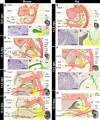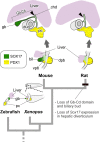Anatomy and development of the extrahepatic biliary system in mouse and rat: a perspective on the evolutionary loss of the gallbladder
- PMID: 29023691
- PMCID: PMC5735046
- DOI: 10.1111/joa.12707
Anatomy and development of the extrahepatic biliary system in mouse and rat: a perspective on the evolutionary loss of the gallbladder
Abstract
The gallbladder is the hepatobiliary organ for storing and secreting bile fluid, and is a synapomorphy of extant vertebrates. However, this organ has been frequently lost in several lineages of birds and mammals, including rodents. Although it is known as the traditional problem, the differences in development between animals with and without gallbladders are not well understood. To address this research gap, we compared the anatomy and development of the hepatobiliary systems in mice (gallbladder is present) and rats (gallbladder is absent). Anatomically, almost all parts of the hepatobiliary system of rats are topographically the same as those of mice, but rats have lost the gallbladder and cystic duct completely. During morphogenesis, the gallbladder-cystic duct domain (Gb-Cd domain) and its primordium, the biliary bud, do not develop in the rat. In the early stages, SOX17, a master regulator of gallbladder formation, is positive in the murine biliary bud epithelium, as seen in other vertebrates with a gallbladder, but there is no SOX17-positive domain in the rat hepatobiliary primordia. These findings suggest that the evolutionary loss of the Gb-Cd domain should be translated simply as the absence of a biliary bud at an early stage, which may correlate with alterations in regulatory genes, such as Sox17, in the rat. A SOX17-positive biliary bud is clearly definable as a developmental module that may be involved in the frequent loss of gallbladder in mammals.
Keywords: biliary tract; gallbladder; modularity; mouse; rat.
© 2017 Anatomical Society.
Figures







References
-
- Berthoud HR, Kressel M, Neuhuber W (1992) An anterograde tracing study of the vagal innervation of rat liver, portal vein and biliary system. Anat Embryol 186, 431–442. - PubMed
-
- Biemar F, Argenton F, Schmidtke R, et al. (2001) Pancreas development in zebrafish: early dispersed appearance of endocrine hormone expressing cells and their convergence to form the definitive islet. Dev Biol 230, 189–203. - PubMed
-
- Breazile JE, Brown EM (1976) Anatomy In: The Biology of the Guinea Pig. (eds Wagner JE, Manning PJ.), pp. 53–62. New York, NY: Academic Press.
-
- Cardinale V, Wang Y, Carpino G, et al. (2011) Multipotent stem/progenitor cells in human biliary tree give rise to hepatocytes, cholangiocytes, and pancreatic islets. Hepatology 54, 2159–2172. - PubMed
Publication types
MeSH terms
LinkOut - more resources
Full Text Sources
Other Literature Sources
Molecular Biology Databases
Miscellaneous

